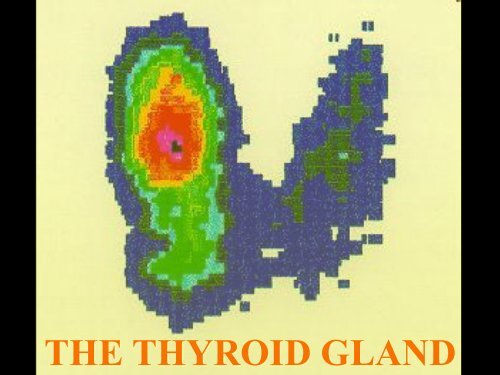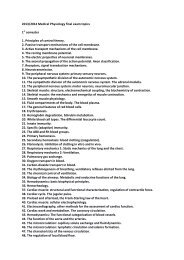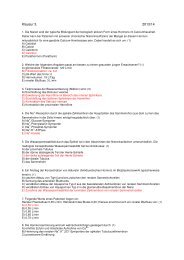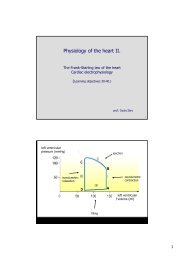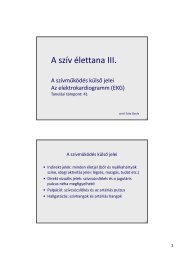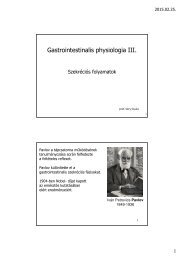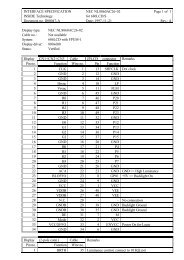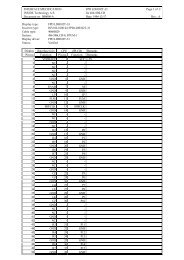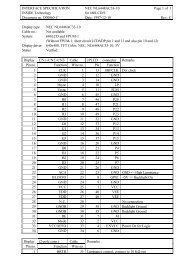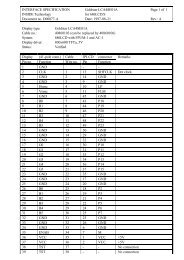Thyroid gland
Thyroid gland
Thyroid gland
You also want an ePaper? Increase the reach of your titles
YUMPU automatically turns print PDFs into web optimized ePapers that Google loves.
THE THYROID GLAND
Emil Theodor Kocher<br />
Switzerland Berne University<br />
Berne, Switzerland<br />
b. 1841- d. 1917<br />
The Nobel Prize in Physiology or Medicine 1909<br />
The Nobel Medical Prize has been<br />
awarded this year to the famous surgeon,<br />
Professor Theodor Kocher of Bern, in<br />
recognition of his work concerning the<br />
physiology, pathology and surgery of the<br />
thyroid <strong>gland</strong>.<br />
The loss of thyroid function results in serious disturbances in this nutrition. Metabolism is<br />
significantly diminished; growth ceases; the skin and the subcutaneous tissues are the site<br />
of mucous infiltration; degenerative processes occur in internal organs; serious<br />
disturbances make their appearance in the functions of the nervous system and muscles. It<br />
became clear that the <strong>gland</strong> acts by elaborating a secretion, which reaches the various<br />
parts of the body. It is, as the expression goes, an internal «secretion».<br />
Through Kocher's exposition it became quite clear that complete extirpation of the thyroid is reprehensible. A portion<br />
of the <strong>gland</strong> which is capable of functioning, must be left behind at operation. This very important principle of surgical<br />
intervention has always been observed from that time onwards. With regard to the surgery of the thyroid, Kocher has<br />
subsequently continued to occupy a leading position.
"Für seine Arbeiten über Physiologie, Pathologie und<br />
Chirurgie der Schilddrüse"<br />
„…no internal secretion exceeds that of the thyroid<br />
in importance to the whole organism. Are doctors<br />
now making use of the newly won province of physiological<br />
therapeutics to the extent that it deserves? Emphatically not.<br />
The reason for this is that, even at the present moment, the<br />
fully developed picture of cachexia thyreopriva is still not<br />
sufficiently well known to every doctor for him to recognize<br />
it immediately in every case. I see a number of patients who<br />
are treated for anaemia, chlorosis, scrofulosis, nervousness<br />
and menstrual disorders, in which the signs of thyroid<br />
insufficiency strike the practised eye at one glance.”<br />
„In my student days it was still the<br />
exception for a goitre operation to meet<br />
with success, so that even very skilled<br />
surgeons fully rejected it.”<br />
(Kocher)<br />
1875: MORTALITY 75%<br />
1912: 0.5% (KOCHER)
Pyramidal<br />
lappen<br />
ULTRASOUND EXAMINATION<br />
Doppler<br />
SCANNING ELECTRON MICROSCOPY<br />
Radiojod-Scintigraphie Knoten
The concept of radioactive tracing was developed by György Hevesy (1885-<br />
1966), the Nobel Prize winner Hungarian scientist. According to the basic idea<br />
the human body cannot distinguish the radioactive isotope of an element from<br />
the non-radioactive one, thus the radioactive isotope of the element can get to all<br />
those organs within the body where the element itself can.
Radioiodine-Scintigraphy<br />
J 131 J 123<br />
99mTc<br />
Toxic multinodular<br />
goiter<br />
Toxic autonomous<br />
nodule
<strong>Thyroid</strong> <strong>gland</strong>: 15-25 g<br />
Blood flow: 5 ml/g/min<br />
Parafollikuläre (”C”) Zellen<br />
(Kalzitonin)<br />
Functional states of thyroid follicular cells<br />
exocrine: Secretion of thyreoglobulin into the thyroid follicles<br />
absorptive: Uptake of colloid via pinocytosis<br />
endocrine: release of the thyroid hormones
Edward C. KENDALL<br />
Kendall hat weitere wichtige Beiträge zur Endokrinologie geleistet. Für die Entdeckung des<br />
Nebennierenhormons Cortison (Compound E) erhielt er im Jahre 1950 gemeinsam mit Tadeus Reichstein<br />
und Philip S. Hench den Nobelpreis für Physiologie oder Medizin (2, 3).<br />
Medizinische Kurznachrichten der Deutschen Gesellschaft für Endokrinologie<br />
(Mediensprecher: Prof. Helmut Schatz, Bochum)
The chemical structure<br />
of thyroid hormones
SYNTHESIS AND RELEASE OF THYROID HORMONES<br />
1. IODINE TRAPPING (iodine pump)<br />
<strong>Thyroid</strong>/Serum free iodine = 25<br />
TSH-dependent – Hypophysectomy: T/S = 5<br />
TSH (iodine deficiency) T/S = 250<br />
LATS<br />
TSH<br />
iodine uptake - absorption<br />
100-150 μg/day<br />
Na/J (Na/iodine symporter [NIS]<br />
inhibited by PERCHLORATE (ClO 4 ), THIOCYANATE (SCN - ),<br />
PERTECHNATe (TcO 4 ), NITRATE (NO 3 ), (competition); LITHIUM.<br />
2. IODINE-OXYDATION<br />
Iodide leaves the cell via pendrin (anion exchanger I - /Cl - )<br />
MICROVILLI - PEROXIDASE<br />
(Inhibited by propylthiouracil)<br />
3. SYNTHESIS OF THYREOGLOBULIN<br />
MW: 660 kDa, GLYCOPROTEIN<br />
acinar cells, ribosomal synthesis
4. EXOCYTOSIS<br />
Excytosis of thyreoglobulin into the colloid<br />
5. Iodination<br />
MIT, DIT<br />
TSH<br />
6. CONJUGATION (COUPLING)<br />
DIT + DIT = T4 + ALANINE<br />
MIT + DIT = T3 + ALANINE<br />
TSH<br />
7. PINOCYTOSIS OF THE COLLOID<br />
Iodinated thyreoglobulin is the thyroid hormone store in the colloid.<br />
(sufficient for 2 weeks)<br />
1/4 MIT, 1/3 DIT, 1/3 T4, + T3<br />
TSH stimulated process<br />
8. PROTEOLYSIS<br />
TSH<br />
Proteolysis of thyreoglobulin in lysosomes - phagolysosomes<br />
release of T3 [10%] und T4 [90%].<br />
9. DEIODINATION (deiodinases)<br />
TSH<br />
10. SECRETION<br />
TSH
Synthesis of thyroid hormones
Hormone transport<br />
T3 (Half life: 24h) and T4 (Half life: 8d)<br />
> 99.5% protein-bound<br />
bound: T 4 =99.98%; T 3 =99.5%<br />
Only the free hormone is biologically active!!<br />
(prevention of filtration in the kidney,<br />
buffer, reserve)<br />
THYROXINE BINDING GLOBULIN (TBG, 54 kDa Glycoprotein)<br />
THYROXINE BINDING PREALBUMIN (TBPA)<br />
ALBUMIN
Hormone production<br />
nmol/d<br />
From thyroid <strong>gland</strong><br />
From tissue metabolismm<br />
Plasma concentration<br />
Total (nmol/l)<br />
Free (pmol/l)<br />
Biological half life (days)<br />
Hormone binding<br />
Biological activity
DEIODINATION<br />
5’/3’-Deiodase Typ I : Liver, kidney, thyroid <strong>gland</strong>, etc.<br />
5’/3’-Deiodase Typ II: Placenta, CNS, Hypophysis
EFFECTS OF THYROID HORMONES<br />
(GENOMIC EFFECTS)<br />
<strong>Thyroid</strong> hormones bind to specific (nuclear) receptors<br />
(nuclear transcription factors)
Effects of thyroid hormones I<br />
GENOMIC EFFECTS<br />
basal metabolic rate<br />
Oxygen consumption<br />
synthesis of 2,3-DPG<br />
thermogenesis<br />
heat loss<br />
Adult: increased production of uncoupling proteins (UPC-3)<br />
Newborn: increased sensitivity of UPC-1 to adrenergic<br />
stimulation (β 3 -receptor)<br />
Metabolism:<br />
increased glucose absorption<br />
Glycogenolysis, Gluconeogenesis<br />
Insulin sensitivity (diabetogenic effect)<br />
Lipolysis, FFA<br />
Cholesterine
Effects of thyroid hormones II<br />
Heart:<br />
Permissive effect:<br />
increased expression of β-receptors<br />
increased catecholamine-sensitivity<br />
positive inotropic, positive chronotropic effects<br />
Increased expression: Myosin heavy chain<br />
calcium-, Na-K-ATPase<br />
Development: brain development<br />
bone development
Frog metamorphosis:<br />
from tadpole to frog<br />
Claudia Fährenkemper<br />
Beine einer Froschlarve<br />
28. Februar<br />
25. März<br />
8. Mai<br />
© Offwell Woodland & Wildlife Trust 1998/9 & 2000/1/2/3/4 http://www.offwell.info<br />
8. Mai<br />
13. Juni<br />
9. Juli
Wenn etwas schief läuft...entsteht aus dem befruchteten Ei nie ein Frosch<br />
Wird ein Axolotl mit Schilddrüsenhormonen gefüttert, kann er sich zum<br />
erwachsenen Molch entwickeln. Seine Kiemen bilden sich zurück,<br />
Lungen treten an ihre Stelle, die Beine wachsen und die Haut verändert<br />
sich.<br />
Ein in Mexiko beheimateter Molch zeigt ganz natürlicherweise eine<br />
verhinderte Entwicklung. Der Axolotl hat eine genetisch bedingte<br />
Schilddrüsenunterfunktion und durchläuft daher keine Metamorphose.<br />
Eigentlich wird er niemals wirklich erwachsen, trotzdem kann er sich<br />
fortpflanzen.
REGULATION OF THYROID HORMONE SECRETION<br />
* Hypothalamo-hypophyseal-thyreoid axis<br />
* Extrathyroid metabolism of thyroid hormones –<br />
activation of T 4 to T 3 (inactivation to rT 3 )<br />
Deiodase-Isoenzymes<br />
* dietary uptake of iodine – iodine metabolism
Hypothalamo-pituitary-<br />
Thyreoid axis<br />
CNS<br />
Inhibition by:<br />
Dopamine, SOM,<br />
Glucocorticoid<br />
Thyreoideastimulating<br />
hormone<br />
T 4 T 3<br />
Thyreotropin-Releasing-Hormon<br />
PROLACTIN<br />
T 3 = TRH Receptor ↓<br />
T 3 = TSH Synthesis ↓<br />
THYROID<br />
Autoregulation of the thyroid <strong>gland</strong>: role of iodine<br />
Schilddrüse: 15-25 g<br />
Durchblutung: 5 ml/g/min<br />
Decreased iodine concentration in blood: uptake of iodine from the GI<br />
Funktionelle tract and increased Zustände der hormone Follikellepithelzellen: synthesis.<br />
High blood iodine concentration: inhibition of T 4 u. T 3 production and<br />
decreased release from thyreoglobulin. [PLUMMER-EFFEKT]<br />
exokriner: Sekretion des Hormons in die Schilddrüsenfollikel<br />
absorptiver: Aufnahme des Kolloids durch Pinozytose<br />
endokriner: Freisetzung der Hormone
pyro-Glu-His-Pro<br />
Glykoprotein, 28 kDa<br />
T 3 , T 4
Effects of TSH<br />
TSH stimulates:<br />
Iodine uptake by follicle cells<br />
[Na/I cotransporter (symporter)]<br />
Iodination<br />
Conjugation (MIT, DIT → T 3 , T 4 )<br />
Endocytosis of thyreoglobulin<br />
Proteolysis (Thyreoglobulin → T 3 T 4 )<br />
Secretion (T 3 , T 4 )<br />
Trophic effect of TSH: Hyperplasia of the thyroid <strong>gland</strong><br />
(increased vascularisation!)
Iodine metabolism
EFFECTS OF IODIDE<br />
In 1948, Wolff and Chaikoff reported that high doses of iodide block<br />
iodide organification in the rat thyroid in vivo. This phenomenon,<br />
known as the acute Wolff-Chaikoff effect, is a reversible process,<br />
because iodide organification resumes when the iodide<br />
concentration in the serum decreases. The mechanisms underlying<br />
the Wolff-Chaikoff effect are complex and involve acute regulation<br />
of several key genes and proteins within the thyrocytes.
DISEASES OF THE THYROID GLAND<br />
1835/1840<br />
morbus Basedow<br />
Henry<br />
Plummer<br />
(1874–1936?)
Die Basedow-Krankheit wurde nach dem Merseburger<br />
Arzt Karl Adolph von Basedow (1799-1854) benannt.<br />
Graves disease owes its name to the<br />
Irish doctor Robert James Graves<br />
(1796-1853)
Graves disease owes its name to the Irish doctor Robert James<br />
Graves, who described a case of goiter with exophthalmos in 1835.<br />
However, the German Karl Adolph von Basedow independently reported<br />
the same constellation of symptoms in 1840. As a result, on the<br />
European Continent the term Basedow's disease is more common than<br />
Graves' disease.[1][2][3]<br />
However, fair credit for the first description of Graves disease ought to<br />
go to the 12th-century Persian physician Sayyid Ismail Al-Jurjani,<br />
who noted the association of goiter and exophthalmos in his Thesaurus<br />
of the Shah of Khwarazm, the major medical dictionary of its time.[7]<br />
Several earlier reports exist but were not widely circulated. For example,<br />
cases of goiter with exophthalmos were published by the Italians<br />
Giuseppe Flajani and Antonio Giuseppe Testa, in 1802 and 1810<br />
respectively.[4] Prior to these, Caleb Hillier Parry, a notable provincial<br />
physician in En<strong>gland</strong> of the late 18th-century (and a friend of Edward<br />
Jenner),[5] described a case in 1786. This case was not published until<br />
1825, but still ten years ahead of Graves![6]
Celebrities with <strong>Thyroid</strong> Disorders<br />
Nadezhda Krupskaya (1869-1939), wife of Vladimir Lenin, was believed to have<br />
suffered from the disease, which caused her eyes to bulge and her neck to tighten.<br />
This was the reason that her Bolshevik codename was 'Fish'. Since Graves'<br />
disease disrupts the menstrual cycle, it is believed that this is why the couple never<br />
had children. (Surgery by KOCHER!)<br />
German folk singer and musician Heino, who has since become famous for his<br />
wearing of dark sunglasses to protect his eyes from bright sunlight.<br />
United States President George H. W. Bush developed new atrial fibrillation and was<br />
diagnosed in 1991 with hyperthyroidism due to the disease and was treated at Walter Reed<br />
Deckname<br />
Army Medical Center with radioactive iodine. By coincidence (or so it is presumed, since the<br />
ultimate cause of this disease remains unknown), the president's wife, Barbara Bush, and the Bushes'<br />
pet dog, a springer spaniel named Millie, also developed the disease
Hyperthyreosis<br />
Morbus Basedow-Graves<br />
man : women = 1 : 8<br />
Cause:<br />
Autoimmune disease<br />
LATS (long acting thyroid stimulator) (80% in Graves')<br />
<strong>Thyroid</strong> stimulating immunoglobulins TSI<br />
Symptoms:<br />
Merseburger Trias:<br />
Goiter, exophthalmus, tachycardia<br />
Increased basic metabolic rate<br />
hypocholesterinemia<br />
shivering, restlessness, sweating, loss of weight despite<br />
good appetite, increased body temperature,<br />
diarrhea, hair loss, psychic changes
<strong>Thyroid</strong> storm (or thyrotoxic crisis)<br />
is an acute, life-threatening, hypermetabolic state induced by<br />
excessive release of thyroid hormones.<br />
Symptoms: fever (above 39 o C), tachycardia, hypertension,<br />
cardiac failure, psychic impairments.<br />
<strong>Thyroid</strong> storm was commonly observed during thyroid surgery, especially<br />
in older children and adults, but improved preoperative management has<br />
markedly decreased the incidence of this complication. Today, thyroid<br />
storm occurs more commonly as a medical crisis rather than a surgical<br />
crisis.
HYPOTHYREOSIS – HYPOTHYROIDISM<br />
The symptoms of hypothyroidism are often varied<br />
and non-specific, weight gain and the inability to<br />
lose weight are two of the most common symptoms<br />
of hypothyroidism.
HYPOTHYREOSIS – HYPOTHYROIDISM<br />
Cause: iodine deficiency in most cases<br />
Symptoms:<br />
Basal metabolic rate decreased (60% ), body temperature decreased<br />
Myxedema: impaired breakdown of hyaluronic acid, chondroitinsulphate,<br />
and mucopolysaccharides; these accumulate in the skin and<br />
bind fluid.<br />
Increased TSH (due to decreased iodine availability)<br />
inhibitory TSH-receptor antibodies<br />
* Heart: cardiomegaly, bradycardia<br />
* Weight gain hypercholesterinaemia<br />
* Dried out hair and skin * Hoarseness (larynx edema)<br />
* Become intolerant to cold * goiter<br />
* Muscles aches and cramps * Depressed and irritable<br />
* Constipation * Some loss of memory<br />
* Decline in Sex Drive<br />
* Irregular Periods
Role of the thyroid <strong>gland</strong> in the<br />
postnatal development<br />
Brain development<br />
Bone development<br />
Hypothyreosis of Newborns (1 in 3600) may cause<br />
Cretenism: Retardation of development including severe<br />
impairments of CNS functions and deafness.<br />
Measurement of TSH in newborns is compulsory!<br />
(early hormone substitution with T 4 is essential.)
Cerebellar<br />
development<br />
Myelinization
Stumpen rauchender Kretine. Ein nicht kropfiger Kretine.<br />
Anmerkung: Ein Stumpen ist im Schweizer Sprachgebrauch eine<br />
maschinengefertigte billige Zigarre.<br />
Nicht kropfige Kretine. Hier ist eindrücklich das damals<br />
als "affenähnlich" beschriebene Gesicht zu erkennen.<br />
© Abt. für Unterricht und Medien AUM, Institut für<br />
Medizinische Lehre IML, Universität Bern<br />
Im Bild zwei kropfige Kretine.<br />
CliniSurf<br />
© Universität Bern, 2013
GOITROGENS<br />
”Goitrogen" is a term used to describe any<br />
substance that can cause enlargement of the<br />
thyroid <strong>gland</strong>. That's because "goiter" is an<br />
enlarged thyroid <strong>gland</strong>. Chemically, goitrogens are<br />
isothiocyanates. These agents inhibit the uptake of<br />
iodine into the thyroid and, consequently, the<br />
synthesis and secretion of thyroid hormones.<br />
Brussels sprouts, cabbage, cauliflower, kohlrabi,<br />
radishes, etc.


